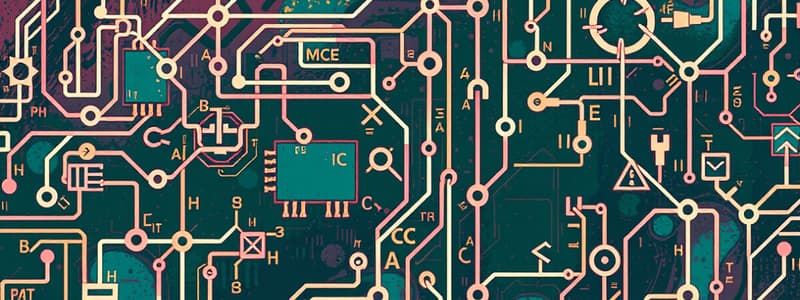Podcast
Questions and Answers
What is crucial for projecting confidence during a Q&A session?
What is crucial for projecting confidence during a Q&A session?
- Using technical jargon
- Combining personal stories with facts
- Maintaining composure (correct)
- Speeding through answers
Which of the following is not a suggested tip for staying composed during a Q&A?
Which of the following is not a suggested tip for staying composed during a Q&A?
- Pause and reflect
- Speak without interruptions (correct)
- Stay calm
- Actively listen
What should you do to enhance your presentation's communication impact?
What should you do to enhance your presentation's communication impact?
- Limit audience interaction
- Focus solely on the content
- Use visual aids thoughtfully (correct)
- Avoid engaging the audience’s emotions
Which action demonstrates effective listening skills during a presentation?
Which action demonstrates effective listening skills during a presentation?
How does effective communication impact an audience?
How does effective communication impact an audience?
Which component is emphasized for enhancing presentations?
Which component is emphasized for enhancing presentations?
What should you anticipate to prepare for a Q&A session effectively?
What should you anticipate to prepare for a Q&A session effectively?
What is more important than just delivering a message in effective communication?
What is more important than just delivering a message in effective communication?
What does a schematic diagram primarily represent?
What does a schematic diagram primarily represent?
Which of the following defines electronic symbols?
Which of the following defines electronic symbols?
How does one decode the number code in electronic symbols?
How does one decode the number code in electronic symbols?
What is the purpose of effective body language in presentations?
What is the purpose of effective body language in presentations?
Which of the following is NOT a technique for effective delivery in presentations?
Which of the following is NOT a technique for effective delivery in presentations?
What is represented by the symbol for a battery in electronic diagrams?
What is represented by the symbol for a battery in electronic diagrams?
Which of the following symbols represents a transformer in electronic diagrams?
Which of the following symbols represents a transformer in electronic diagrams?
What does the abbreviation used for a fuse signify in electronic symbols?
What does the abbreviation used for a fuse signify in electronic symbols?
Flashcards are hidden until you start studying
Study Notes
Electronic Symbols and Diagrams
- Schematic diagrams visually represent systems/processes using symbols, lines, and arrows, illustrating connections and flow of components.
- Different electronic components are indicated using symbols; understanding these is essential in decoding their meanings through an alphabetic code (1=A, 2=B, etc.).
Key Electronic Components
- Battery: A source of electrical energy stored in chemical form.
- Fuse: A safety device that protects circuits by breaking the connection when excessive current flows.
- Transformer: An electrical device that changes voltage levels in alternating current circuits.
- Resistors: Used to resist the flow of current, include:
- Fixed Resistor: Offers a constant resistance.
- Potentiometer: A variable resistor that adjusts resistance manually.
- Trimmer: A small adjustable resistor used for fine-tuning.
Capacitors
- Components that store electrical energy temporarily, types include:
- Capacitor: General term for the component.
- Polarized Capacitor: Has a positive and negative lead and is used in DC circuits.
- Variable Capacitor: Allows for adjustment of capacitance.
Diodes
- Diode: A semiconductor device that allows current to flow in one direction.
- Types include:
- Zener Diode: Allows current to flow in reverse above a certain voltage.
- Photo Diode: Converts light into electrical current.
Measurement Tools
- Voltmeter: Measures voltage across a component.
- Galvanometer: Measures small currents.
Presentation Skills
- Effective delivery in public speaking involves varying pitch, tone, and volume to convey emotions.
- Key techniques include maintaining eye contact, purposeful gestures, and good posture.
- Anticipating audience questions and rehearsing responses is crucial for confidence during Q&A sessions.
General Communication Impact
- Effective communication resonates with the audience's experiences and values, leaving a lasting impression.
- Engaging the audience requires meaningful interactions and adapting messages to their interests.
Visual Aids in Presentations
- Selecting the right visual aids enhances understanding and retention of information.
- Use visuals like diagrams of components, which align with the topic being presented.
Additional Components
- Inductor: Stores energy in a magnetic field when electrical current flows through it.
- Buzzer: An audio signaling device involving electric sound generation.
- Earphone and Loudspeaker: Output devices used to convert electrical signals into sound.
Conclusion
- Understanding electronic symbols and their components is crucial in electronics and communication effectiveness. Engage the audience by selecting suitable visuals and practicing presentation techniques.
Studying That Suits You
Use AI to generate personalized quizzes and flashcards to suit your learning preferences.




